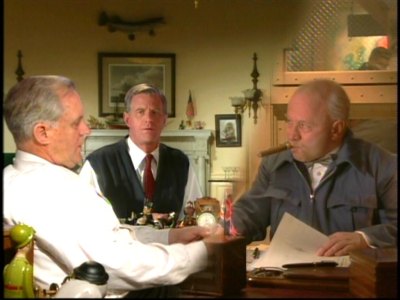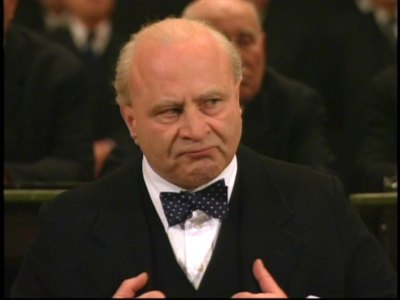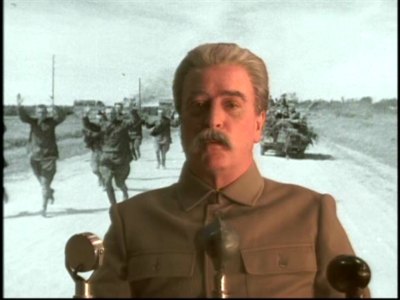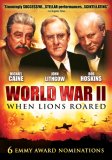| Reviews & Columns |
|
Reviews DVD TV on DVD Blu-ray 4K UHD International DVDs In Theaters Reviews by Studio Video Games Features Collector Series DVDs Easter Egg Database Interviews DVD Talk Radio Feature Articles Columns Anime Talk DVD Savant Horror DVDs The M.O.D. Squad Art House HD Talk Silent DVD
|
DVD Talk Forum |
|
|
| Resources |
|
DVD Price Search Customer Service #'s RCE Info Links |
|
Columns
|
|
|
World War II - When Lions Roared
I would imagine that the 1994 TV miniseries, World War II: When Lions Roared, is exactly the kind of film that serious WWII history buffs love to chew over and discuss. Focusing entirely on three giants from the world's greatest global conflict - FDR, Churchill, and Stalin - World War II: When Lions Roared starts with the London Blitz, and supposedly takes each leader's own words, and skillfully interweaves them as these politicians (and one dictator) warily circle each other, trying not only to beat the greatest threat to their own existence (Hitler and Germany), but also trying to hang on to (and possibly expand) their own nation's borders and influence once the conflict is over.

I say "supposedly" because I'm certainly no WWII history expert. As well, the screenwriter and producer David W. Rintels, and director Joseph Sargent, compress events, and through an innovative staging technique, have the leaders interact with each other out of their proper time context. Now that drives some historians nuts when filmmakers do that, but as movie lovers know (and that means you, smart reader), to convey five years of history into a three hour movie, there's going to be some cutting, and there's going to be some creative rearrangement of the "real" facts. I found the technique utterly fascinating when I saw it here. It's rather theatrical, in the classical sense, but somehow, it works very well here cinematically. Let me try and explain more clearly how director Sargent does this.
Sargent may start off a scene with FDR (John Lithgow) speaking with his aid and advisor Harry Hopkins (Ed Begley, Jr.). As they discuss (with the actors in a two-shot) the materiel that England desperately needs, we hear Winston Churchill (Bob Hoskins) offscreen interrupt them, reciting from a letter sent to FDR, answering the discussion they're having right now. Now, in most films, the offscreen audio of Churchill would have been a cue to cut to Churchill and a new scene, but Sargent has Lithgow and Begley turn and react as if Churchill was in the room with them, listening to them. Then, in a split screen, we see Churchill discussing what must be done, as FDR listens patiently. Then, once an agreement is made, Sargent may have Joseph Stalin (Michael Caine) interrupt, with Churchill reacting as if Stalin entered the room as well. Of course, anybody who's seen a stage production will recognize this classical staging technique of linking people and ideas from different locations and even times into the same scene, but you certainly don't see it that often in WWII TV miniseries, and I found it terrifically involving. Sargent goes even further in honoring theatrical methods by having characters give asides right to the audience, much like a narrator or chorus might in a stage production. It's also a nice way to incorporate even more factual material into the show.

Having the film shot on Hi-Def adds immediacy to the proceedings, as well. There's a certain clarity to the image (master D.P. John A. Alonzo's work) that does give a decidedly different look to images we normally associate with grainy black and white. The cinematic "idea" of WWII has become accepted as a black and white world on film - just look at Spielberg's Saving Private Ryan and Eastwood's Flags of Our Fathers; two modern WWII films where the color scheme was desaturated to give almost a monochromatic feel. So when you see these world figures, whom we've seen portrayed numerous times on film, shot on vivid, clear video, it gets your attention. The very idea that it's video, and that we know it's video and not "old" film, makes the dramatics somehow seem more contemporary. Or at least more immediate. It's another interesting choice from director Sargent.
I've always been a big fan of Joseph Sargent's work. Dismissed with left-handed compliments like "competent craftsman" and "proficient journeyman" (monikers that spelled critical oblivion in the auteur-obsessed 1970s), Sargent is a most underrated helmer. Contributing one of the best TV movies ever made (1970's Tribes with Darren McGavin and Jan-Michael Vincent), along with one of the top five suspense films of the 1970s (1974's The Taking of Pelham 1, 2, 3, with Walter Matthau), Sargent's super-clean, efficient style reminds me of the best of the studio directors from the Golden Age of Hollywood. And here in World War II: When Lions Roared, it's no different. Working with the technical challenges of filming in Hi-Def, along with the complicated logistics of staging the split screens and video mattes, Sargent takes what amounts to three hours of talking heads material, and makes an engrossing, speedy film that plays more like it's 90 minutes. It's great to see that today, at 82 years old, he's still working on big projects like the upcoming remake of Sybil.
The cast for World War II: When Lions Roared is interesting, to say the least. John Lithgow as FDR struck me as strange casting at first, because Lithgow's usual manic overplaying seems at odds with the jovial, but decidedly patrician and reserved FDR. But Lithgow does quite well with the character, getting across the President's foresight in believing that England had to be saved at all costs if the Western world was going to survive Hitler's onslaught. Bob Hoskins, a gruff, immensely talented actor whom I would have never imagined as Winston Churchill, suddenly becomes perfectly cast as Churchill, and makes you wonder why you never thought of the actor in that role in the first place. He may not get the accent right all the time, but the steely, wily politician shines through, and Hoskins really delivers the goods here. I guess the strangest casting has to be Caine as Stalin. How they came to that decision I don't know, but Caine, regardless of the role, is always interesting, and with his affinity for playing bad guys, Caine gets his chance to play one of the worst bad guys of all time. With his self-proclaimed "hooded cobra" eyes, Caine is oddly effective as the Communist mass-murderer. While you never really believe it's anybody but Caine, he's absolutely spot-on when it comes to getting across unspoken volumes of Stalin's personal demons, hatreds, and psychoses, into his line readings and his silent, close-up reaction shots (his first scene is marvelously creepy, as Stalin sits motionless, contemplating the fate that awaits Russia). The film's most bizarre bit of casting becomes the film's biggest surprise success.

The DVD:
The Video:
With the original elements shot on Hi-Def video, the full-frame video transfer for World War II: When Lions Roared is flawless.
The Audio:
The Dolby Digital English 2.0 mono soundtrack is fine for this dialogue-driven movie. There are no subtitles or close-captioning options.
The Extras:
There are no extras for World War II: When Lions Roared.
Final Thoughts:
You don't have to be a history or World War II buff to enjoy the innovative TV miniseries World War II: When Lions Roared. Michael Caine, Bob Hoskins, and John Lithgow give layered, nuanced performances as world leaders Stalin, Churchill, and FDR, and screenwriter David Rintels and director Joseph Sargent expertly weave reams of actual writings and sayings from these historical figures into an engrossing, insightful three hour experience. This is drama, first and foremost, not just a history lesson, and it's a stylish, intelligent success. I highly recommend World War II: When Lions Roared.
Paul Mavis is an internationally published film and television historian, a member of the Online Film Critics Society, and the author of The Espionage Filmography.


|
| Popular Reviews |
| Sponsored Links |
|
|
| Sponsored Links |
|
|
| Release List | Reviews | Shop | Newsletter | Forum | DVD Giveaways | Blu-Ray | Advertise |
|
Copyright 2024 DVDTalk.com All Rights Reserved. Legal Info, Privacy Policy, Terms of Use,
Manage Preferences,
Your Privacy Choices | |||||||














